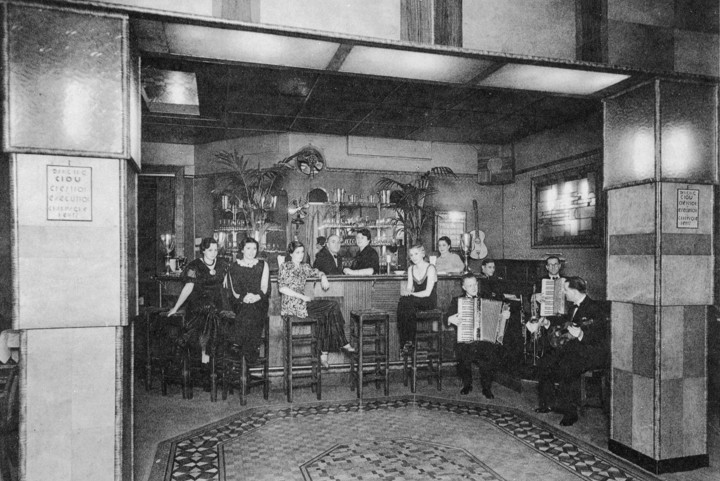(Re)discover the city: Clou-Bar – Charly’s – Scorpion – Byblos

Think you know Luxembourg City well? Think again! Some buildings you pass by every day hold fascinating, hidden stories. Dr. Robert L. Philippart, a true expert in the field, takes us on a journey through the city to uncover these lesser-known histories and give you a new perspective on some of its most iconic buildings.
The construction site of the underground parking beneath Place des Martyrs is nearing completion. This square in the city centre is relatively recent. It was only in 1937 that the Government commissioned landscape architect Henri Luja to design a flower-filled square. The land, part of the old fortress grounds, had been transferred to the State after the fortifications were dismantled.
By 1875, the last military remnants had disappeared, and the districts surrounding the Bourbon Plateau had begun to flourish. These areas were made up of private land and fell within the Hollerich commune. After the construction of the Adolphe Bridge (1900–1903), the State had French town planner Edouard André and German planner Josef Stübben propose plans to develop the neighbourhood. A special development plan for the Bourbon Plateau was adopted in 1906.
The avenue was built in two phases: in 1904, the year it opened to traffic, and in 1911 at Place de Metz. The central plots were reserved for significant buildings. The one facing the Upper Town was intended to house either a national museum or a courthouse.
In 1922, it was decided that this location would host the headquarters of the steel company Aciéries Réunies Burbach, Eich et Dudelange (now BCEE, No. 19). The opposite plot was to be used for housing. Along Avenue de la Liberté, buildings were allowed to have three floors plus an attic, whereas the narrower side streets like Rue Plébiscite and Rue de la Grève could only accommodate two-storey buildings with attics. These side street buildings were erected between 1923 and 1930 — long before the central area was transformed into a square — explaining the height discrepancy between them and the square built later.
The first entertainment venue to settle on Place des Martyrs was the Écran cinema (later The Yank) in 1928. In 1930, the Beethoven Hotel opened with about ten rooms. Although its proximity to the ARBED headquarters was advantageous, it couldn’t compete with larger, better-equipped hotels nearby and closed its doors in 1933. Located at No. 3 Rue Beethoven, the hotel took its name from the street, which was only renamed Rue du Plébiscite in 1946.
The site quickly gained a reputation thanks to the opening of the “Clou Bar” in 1931, one of the city’s major nightspots. The dance hall, decorated in Art Deco style and lit with indirect lighting, featured two accordionists and a violinist. The Clou Bar was a renowned jazz venue with artists such as Johnny Horn, Johnny Glesener, Willy Hülsemann, Andy Felten, and René Schmit, as well as bands touring from Paris. Even during the war, the Clou Bar remained open daily from 7 p.m., offering live entertainment. The music programme changed every Friday, in line with cinema schedules.
In 1946, Charles Bormes took over and renamed the place “Charly’s Bar.” One of the bar’s most famous guests was Udo Jürgens in 1981. The bar even installed illuminated signs across the city to attract tourists and business travellers. It continued to feature live bands, such as Baby Paris, Léopold Swingtet, The 5 Italian Crazies, and Jay Roy from Hilversum Radio. Nights were long and rarely ended before 4 a.m.
In 1947, architect Robert Lentz — who would later design the Robert Schuman monument — created the city’s most stylish bar. The revamp removed the cherub reliefs below the cornice and the decorative elements on the ground floor. The interior featured a rounded bar with 24 stools, seven armchair-lined tables, and a lounge with a dance floor in the back. Large mirrors, red and gold faux masonry columns, indirect lighting, and a Florentine chandelier gave the venue a chic ambiance.
In 1975, the “Scorpion” nightclub, one of seven in the capital, took over and remained until 1981. The “Byblos” nightclub then occupied the premises until 2007. Today, the building houses offices.
Research & Text:
Robert L. Philippart
Photo credits:
Clou-Bar © Henri Kugener Collection / Photothèque de la Ville de Luxembourg
Hôtel Beethoven © Kugener Collection / Photothèque de la Ville de Luxembourg
Charly’s Bar © Kugener Collection / Photothèque de la Ville de Luxembourg
Scorpion sticker
Former Byblos sign © Rolph
Inscrivez-vous
à la newsletter.
Inscrivez-vous et recevez tous les mois l’actualité shopping de la ville directement par email ! Bon plans, événements phares, nouveaux commerces, ne manquez rien de l’actualité commerçante.
Cityshopping news








